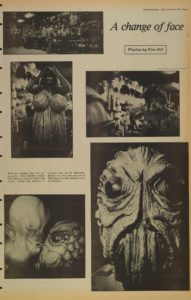News Stories

When Hobgoblins Walk
How The Michigan Daily Has Covered Halloween Through the Years
By Alex Boscolo
Since 1890, The Michigan Daily has been the authoritative voice on student life. And when it comes to Halloween, it hasn’t shied away from covering all types of student shenanigans and general tomfoolery.
Here is a brief look at student life on campus from the pages of the Daily at the spookiest time of the year.
November 1st, 1893
Early Halloween celebrations in America featured bonfires and storytelling, but by the turn of the nineteenth century, the festival was increasingly associated with prank-pulling, especially among young men. Campus was no exception. In 1893, the Daily reported that “Last night about 600 students from the various departments gathered on the campus for the purpose of celebrating Hallowe’een in good old-fashioned style. The best of humor prevailed throughout the proceedings, which consisted of rushes, bonfires, etc. Nothing more serious than blocking the street railway, and tearing down some old fences was indulged in.”
October 26, 1924

A Halloween merchant advertisement in the Daily, October 1924.
Hoping to take advantage of the popular holiday, a number of local advertisers placed a full-page sheet in the Daily (see image, left). The copy read: “HALLOWE’EN—the night when hobgoblins walk, when owls hoot and black cats screech—has been handed down to us through generations as an evening for merriment and fun. / And all of us, young and old, have youth enough or memories of youth to enjoy the innocent pranks of Hallowe’en. / Hallowe’en parties are enjoyed by all. They not only afford loads of fun for the grown-up but keep the children off the streets—substituting innocent fun for what be dangerous and destructive otherwise. / The merchants on this page will help you give your Hallowe’en party—give it right and at little cost.” What goods might be needed to give the right party? If advertisers are to be trusted, then it was meats, waffles, pastries, and flowers.
October 28, 1949
Greek life was in full swing on campus, and the Daily regularly reported on which social gatherings students could attend for the holiday. Halloween themes ranged from masquerade to blue-jean barbeque. At Chi Omega, guests would have to climb ladders to enter a “gala Halloween party,” wherein they might encounter “a group of ghastly witches” or a room of horror “like a giant spider web.” At Zeta Tau Alpha, “skeletons, black cats, and witches will be found. . . cider, doughnuts, and apples will be served as refreshments.”
October 30, 1981

The Michigan Daily, October 30, 1981.
By 1981, costumes ruled the day. The Daily writers got into the spirit, reporting that “with the witching hour fast approaching, those familiar campus faces take on a different look as the clowns, goblins and monsters in everyone creep out for Halloween. Beware! You may bump into one of these faces on a dark, deserted street this weekend.”
October 25, 2001
Historically, Halloween coverage has been influenced by current events. In the early days of the paper, fraternity parties were featured alongside church get-togethers. In the 1940s, Halloween calendars ran next to pieces about Japanese internment. In 2001, the Daily interviewed the owner of a costume shop who remarked that “The [9/11] terrorist attacks have inspired some customers in their costume selections. . . We’re out of our Statue of Liberty (costumes) for rental.”
October 27, 2008

A student dressed as Tinkerbell was featured in the Daily article “Dressed to Kill” (October 31, 1997).
In 2008, a sports column offered some timely advice for students to dress up as the Michigan State football team. The author suggested that interested parties might “brag to everyone at the party about how you finally beat your big brother at something. Never speak in complete sentences. Lose your last four games of ping pong.”
Anyone who chooses to celebrate Halloween might do well to heed the Daily’s advice, printed on October 25th, 2001: “A successful Halloween party is not as simple as the typical keg-in-the-bathtub, dance-music-blasting, black-light-glaring bash that can be found on any given weekend.” Rather, it’s “a fine art that must be mastered with care and precision.”
Lead Image: A Daily ad for Greene’s Microclean—“Give your clothes a beWITCHING appearance,” October 24, 1937.
